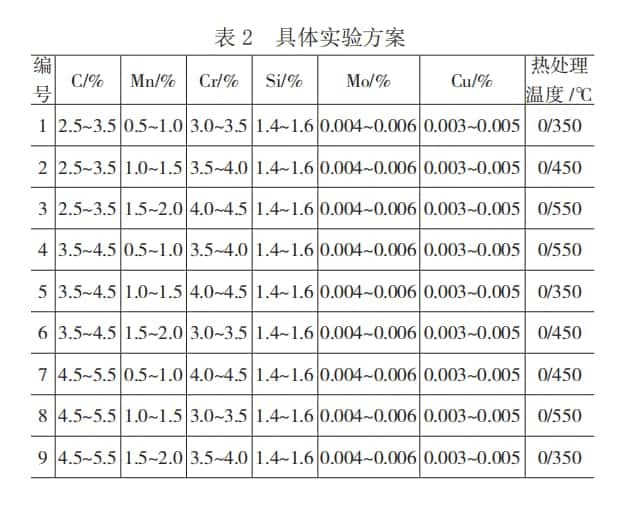Study on production process of low-cost new wear-resistant grinding balls (1)
Abstract:The effects of chemical composition and heat treatment on properties of the wear-resistant grinding balls were studied through hardness and impelling strength test, metallographic structure analysis. The study used an orthogonal test instead of a fixed variable method for a shorter experimental cost and time. The experimental results show that the wear-resistant grinding balls show the best integrative properties, the lowest cost, and lest production difficulty.
Keywords: wear-resistant grinding balls; chemical composition; heat treatment
Classification: TG250; Document Id: A; article ID: 1006-9658(2017)02-0026-03
1.Introduction
The ball mill is the leading equipment of the grinding process in cement, electric power, mine, and other industries. The ball mill is one of the main wearing parts of the ball mill. Cast Iron Alloy grinding ball is one of the most widely used materials. High-chromium, medium-chromium alloy ball because of its high macro-hardness, good wear resistance, no extraordinary heat treatment process and other characteristics, popular power, cement, and other industries. Low Chromium Alloy Ball is widely used in wet grinding of ore because of its obvious price advantage, although its performance is a little worse. A large number of market demand for the emergence of low-cost, high-performance grinding ball research upsurge. How to develop a lower-cost grinding ball preparation process without affecting the grinding ball performance has become a current grinding ball production enterprise. The number one problem in business.
On the basis of the principle of minimum equipment and experiment cost and shortest experiment period, the chemical composition ratio, and heat treatment temperature of wear-resistant grinding balls are studied by using medium frequency induction furnace melting and orthogonal test method. Based on industrial tests, the production process of grinding ball with good hardness and impact property, low production cost, and simple working procedure is explored.
2.Scheme Design and sample preparation
2.1 experimental design
Generally speaking, the higher the C’s content, the higher the hardness, the better the wear resistance, but the Brittleness of the wear-resistant grinding balls increases, easy to be broken in use. Cr can improve the carbide phase structure in white cast iron, change the distribution form of Matrix and carbide, and make the grinding ball have better mechanical properties. C/Cr is the most important part of grinding ball composition design. Mn can promote the formation of pearlite and Ledeburite, refine pearlite and improve the strength and hardness of cast ball. Mo Element can refine the grain, improve the hardenability, and improve the grinding ball’s toughness. Cu is a non-carbide forming element, which can be dissolved in-Fe, increase the Matrix’s electrode potential, reduce the micro-battery action in the corrosive medium, and effectively reduce the corrosive wear rate. Reference data, combined with the actual production experience of the elements of this article changes in the scope of table 1.
The content of SI in raw materials is often high in practical production. When using ferrosilicon to change Si’s range, it is easy to change other components. Therefore, the content of Si is not a factor of experimental change, and it is kept at 1.4% ~ 1.6%. Rare Earth elements can effectively purify the molten iron and improve the grain boundary condition. In practice, rare earth elements are mostly used to improve grinding balls’ toughness, but the price is very high. To reduce the cost of products, a combination of trace Mo and Cu is used instead of rare earth elements, as the addition amount is very small, Mo is controlled at 0.004% ~ 0.006%, and Cu is controlled at 0.003% ~ 0.005%. In order to better explore the balance point between the grinding ball performance and the energy consumption cost, each group of samples in this paper is compared by non-heat treatment and heat treatment, respectively, the heat treatment temperature is mainly controlled around 350 °C, 450 °C and 550 °C. The orthogonal experiment method was used to design the experiment, and the concrete experiment scheme is shown in Table 2.
The smelting process is conducted in a 750kg fast-medium frequency induction furnace with a melting temperature of 1550 ~ 1650 °C, which ensures the best temperature fluctuation and concentration fluctuation in the whole smelting process, and the furnace temperature is controlled at about 1650 °c (detected by a thermocouple), the slag content and gas content of molten iron is minimized to ensure the output of high-quality test grinding balls. The casting temperature is 1350 ~ 1380 °c, the slag is removed, the alloy is added in the ladle, and the molten iron is injected and stirred fully to prevent segregation of composition. After that, the slag-collecting material is added to make the liquid iron clean enough, the slag should be paid attention to in the whole casting process, and the impurity should not be involved in the mold. Heat treatment starts from room temperature and rises at the speed of 50 °C/h to the required heat treatment temperature for 2h, then air-cooled to room temperature.



